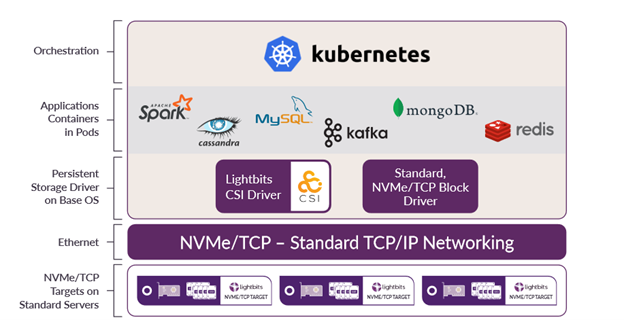At Lightbits, we get the transformative power of container technology and the increasing adoption of platforms like Kubernetes. I&O teams face immense pressure to architect environments that are not only scalable and high-performing but also fault-tolerant, ensuring zero downtime. Containerized applications, orchestrated by Kubernetes, offer a compelling solution by enabling rapid deployment and termination of applications with minimal overhead. Datadog’s latest report (as of mid-April 2025) analyzing data from billions of containers suggests continued growth in container adoption, particularly in areas like serverless containers and GPU-based compute for AI/ML workloads.
However, the relentless data growth in today’s “always-on” data centers introduces a critical challenge. Applications running at scale within Kubernetes storage solutions must maintain their state as they migrate across the data center. This is crucial for sustained availability and operational efficiency amidst constant data platform changes. The physical proximity of the underlying data can significantly impact the latency of application response times.
Traditional DAS architectures exacerbate this challenge. When a containerized application or service is rescheduled onto a node distant from its data, it undergoes a time-consuming “warm-up” phase. This involves reconstructing its state by retrieving data from neighboring nodes hosting replicas or shards. Introducing persistent volumes within container schedulers like Kubernetes addresses this “warm-up” problem. Today, leading orchestration platforms support persistent volumes through the standard Container Storage Interface (CSI), paving the way for more robust Kubernetes storage solutions.

Limitations of Direct-Attached Storage Architecture:
- Applications locked to servers and storage, resulting in siloed CPU and NVMe® storage, which leads to low resource utilization
- App-based replication and recovery over the network result in rebuild times that degrade services and impact the network
This modern containerized architecture necessitates a disaggregated storage technology capable of delivering the inherent scalability and performance required to efficiently manage and process ever-increasing data volumes. However, adopting new technologies for containerized applications within a live production environment must be a gradual process, minimizing disruption and ideally requiring minimal to no new hardware investments.
At Lightbits, we work with our customers to understand the mobility challenges of running containerized applications and identify the best solutions that are deployable in their current environment with minimal friction.
We recognize that our customers require the agility to spin up containers without being constrained by data and application affinity. True cloud-scale storage transcends physical distance limitations and specialized use cases; it’s about extending seamless data access across the entire data center. This understanding has driven our solution design, which is centered around reliable and widely adopted network infrastructure and protocols proven for their scalability.
Our answer is software-defined storage accessed over standard TCP/IP networks. This approach enables the deployment of lightweight containerized applications with persistent volume access without mandating new hardware acquisitions or significant changes to existing operational workflows.

Scale-out software-defined storage effectively resolves the data mobility challenge by providing fine-grained access controls to data from any server location within the data center. Recognizing the critical importance of scale and the growing momentum of NVMe and NVMe-oF as key technologies for meeting modern data center demands, Lightbits invented the NVMe over TCP. This robust and efficient storage protocol has been officially ratified as an NVMe standard and is supported in the Linux kernel.
Lightbits’ NVMe over TCP-based software-defined storage solution offers immediate deployability within existing data centers and Red Hat OpenShift environments. It empowers a lightweight containerized service application architecture backed by a scalable, high-performance disaggregated storage system, providing a modern Kubernetes storage solution.
To learn more about NVMe over TCP, read the blog: NVMe Storage: A Beginner’s Guide to Lightning-Fast Data Access

